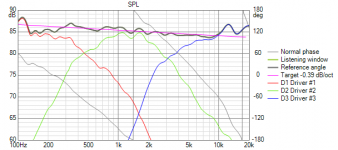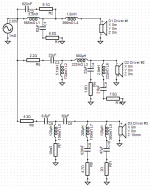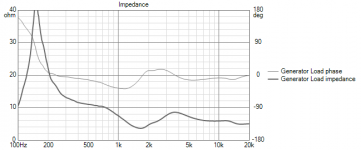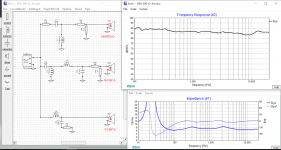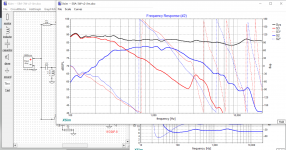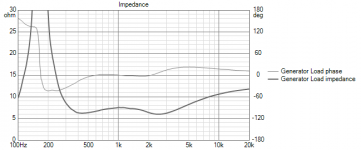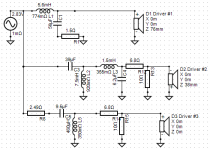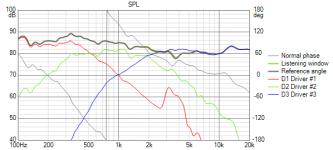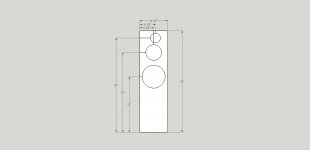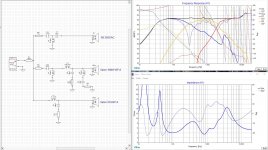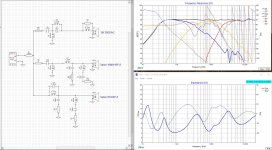My try. Curves traced from SB' factory data.
Just another opinion, and a rough simulation as an exercise.
Min Z is 3R7.
There is no substitute for actual measurements!
Just another opinion, and a rough simulation as an exercise.
Min Z is 3R7.
There is no substitute for actual measurements!
Attachments
You can see in this setup that 1x WO24 is out of place. It would be best to use more effective woofer or 2xWO24.
I traced it again. It is different but it is still difficult to work with. Maybe you could try a notch filter instead of the parallel resistor (you can still use a parallel resistor as part of an L-pad if you want the impedance to stay lower).
[Rename the file by removing .txt]
Hi
Do you have sb29sdac FRD and ZMA?
I gave this crossover a shot. I am no expert, but this is what I came up with. This is just a starting point until you get your actual drivers into your cabinet, and make actual measurements. But this simulation shows that with these drivers you have a high likelihood of success.
Minimum impedance is 6 Ohms at about 100 Hz. Crossover frequencies are about 450 Hz and 2000 Hz. Image 2 shows the crossover from woofer to mid. Image 3 shows the crossover from mid to tweeter. I used AllenB's latest frd and zma files.
Baffle Step Compensation: I do not know what the shape of your baffle will be, but I assumed you will need some amount of BSC. I wanted to get a 7 dB drop from 100 Hz to 1000 Hz, but I could only manage to get about 5 dB drop. Maybe this can be adjusted by someone who is more skilled than me. It might be best to wait until your drivers are installed in your cabinet and measure how much BSC you will need.
Driver offset: I assumed you would be using a flat baffle that is not stepped or sloped. I delayed the MW16P by 1.5 inch, and the bass driver by 3 inch. This is a good guess, but acoustical measurements can confirm the exact values.
I recommend using R1 for final voicing. You can raise or lower the level of the tweeter by several dB with this component and it does not affect the rest of the tweeter filter.
Minimum impedance is 6 Ohms at about 100 Hz. Crossover frequencies are about 450 Hz and 2000 Hz. Image 2 shows the crossover from woofer to mid. Image 3 shows the crossover from mid to tweeter. I used AllenB's latest frd and zma files.
Baffle Step Compensation: I do not know what the shape of your baffle will be, but I assumed you will need some amount of BSC. I wanted to get a 7 dB drop from 100 Hz to 1000 Hz, but I could only manage to get about 5 dB drop. Maybe this can be adjusted by someone who is more skilled than me. It might be best to wait until your drivers are installed in your cabinet and measure how much BSC you will need.
Driver offset: I assumed you would be using a flat baffle that is not stepped or sloped. I delayed the MW16P by 1.5 inch, and the bass driver by 3 inch. This is a good guess, but acoustical measurements can confirm the exact values.
I recommend using R1 for final voicing. You can raise or lower the level of the tweeter by several dB with this component and it does not affect the rest of the tweeter filter.
Attachments
I would read the Jeff Bagby's write up on kairos and continuum 3way
There is a kinda universal solution for a woofer module for existing designs. You can take Jeff's kairos/adelphos/continuum/revolution or any other proven design and add the woofer module, making it 3 way. Jeff leaves a lot to your personal taste, the sub, the enclosure and is a nice point to start. I am an the same page, probably going for an sb revolution mini and and combo with the sb29nrx woofer (or a 2.5 way with satori, haven't decided it yet)
There is a kinda universal solution for a woofer module for existing designs. You can take Jeff's kairos/adelphos/continuum/revolution or any other proven design and add the woofer module, making it 3 way. Jeff leaves a lot to your personal taste, the sub, the enclosure and is a nice point to start. I am an the same page, probably going for an sb revolution mini and and combo with the sb29nrx woofer (or a 2.5 way with satori, haven't decided it yet)
Last edited:
I have the SB29NRX75-6. GREAT at the low bass only; in my opinion, if you want a more accurate bass much above 200 Hz, look elsewhere. The Vifa/Tymphany/Peerless NE265 is said to be WAY better (musically) than the SB29 all around. I am very happy with the SB29; don't get me wrong. It just doesn't have the higher resolution or definition in the mid and upper bass I so strongly crave. In my case; I am attempting to fill this in with a very well designed 8 inch nominal woofer. I also have the Satori MR16 and MW16 both. They can't take the power I want to give them so I'm moving to a larger driver for use above the SB29s. I LOVE the sound of the MR and MW 16 Satoris both for sure; in my current build though; I need higher SPL and power handling BOTH in the bass. Neither Satori can do this for me; closed box even with a 2nd order HP they still "run out of gas" too soon for "MY" needs. If you don't need tons of SPL; the Satoris are REALLY hard to beat for sure. Just my 2c...
I have that write up paper that you mention.
in fact I have a good proven crossover for woofer/mid, the problem comes with mid/TW section.
This crossover was intended to be used with the satori TW29BN instead of SB29SDAC thats the why...
in fact I have a good proven crossover for woofer/mid, the problem comes with mid/TW section.
This crossover was intended to be used with the satori TW29BN instead of SB29SDAC thats the why...
I would read the Jeff Bagby's write up on kairos and continuum 3way
There is a kinda universal solution for a woofer module for existing designs. You can take Jeff's kairos/adelphos/continuum/revolution or any other proven design and add the woofer module, making it 3 way. Jeff leaves a lot to your personal taste, the sub, the enclosure and is a nice point to start. I am an the same page, probably going for an sb revolution mini and and combo with the sb29nrx woofer
I know there are much better solutions than this woofer, this mid and this tweeter, but the problem is that I already have all of them and I would like to pair them as good as possible.
This was going to be like a TROELS SBA 941 build, but it came to me the MW16P instead the MW13P and the SB29SDAC instead of Satori TW29RB....
I have played with the crossover and I got a good crossover for woofer/Midrange. If I had the Satori TW29BN I could mate to the MW16-P, but I don't want to spend another 250€ on them if I can mate the SB29SDAC.
I have studied some Jeff Bagby SDAC crossovers and they don't work.
I made an approach and would like to have tour opinions wether if it will work or it can be improved before ordering parts.
Anyway I will order more parts than needed and will try to tune it listening them.
This was going to be like a TROELS SBA 941 build, but it came to me the MW16P instead the MW13P and the SB29SDAC instead of Satori TW29RB....
I have played with the crossover and I got a good crossover for woofer/Midrange. If I had the Satori TW29BN I could mate to the MW16-P, but I don't want to spend another 250€ on them if I can mate the SB29SDAC.
I have studied some Jeff Bagby SDAC crossovers and they don't work.
I made an approach and would like to have tour opinions wether if it will work or it can be improved before ordering parts.
Anyway I will order more parts than needed and will try to tune it listening them.
I have the SB29NRX75-6. GREAT at the low bass only; in my opinion, if you want a more accurate bass much above 200 Hz, look elsewhere. The Vifa/Tymphany/Peerless NE265 is said to be WAY better (musically) than the SB29 all around. I am very happy with the SB29; don't get me wrong. It just doesn't have the higher resolution or definition in the mid and upper bass I so strongly crave. In my case; I am attempting to fill this in with a very well designed 8 inch nominal woofer. I also have the Satori MR16 and MW16 both. They can't take the power I want to give them so I'm moving to a larger driver for use above the SB29s. I LOVE the sound of the MR and MW 16 Satoris both for sure; in my current build though; I need higher SPL and power handling BOTH in the bass. Neither Satori can do this for me; closed box even with a 2nd order HP they still "run out of gas" too soon for "MY" needs. If you don't need tons of SPL; the Satoris are REALLY hard to beat for sure. Just my 2c...
I gave this crossover a shot.
Jim
I applied your exact xo, with the delays as you advised, on the same 60 dB scale, impedance is on 30 Ohms scale since Vituix V2 doesn't have 24 Ohms.
But the files are my traces taken from SB site, with Vituix tracer, which works very good, and I do take care of checking the graphs' values so I assume they are pretty accurate (to the published). You used a different set of files, and that's fine. The two sets of inputs obviously differ, so do the outcomes.
The point is, like you stated yourself, the most important thing is to work with actual measurements taken properly, with drivers in the the actual enclosure. These simulations with IEC-baffle measurements* can only indicate a suitability and compatibility of various drives, but can't be taken as a final design. This is mostly a well-intended comment for the OP, since the drivers planned are excellent and deserve a properly designed and executed system.
*Edit: AFAIK only SEAS offers measurements taken in an actual enclosure, with it's size clearly stated. If there are others, I am not aware of them.
Attachments
Last edited:
Understand 100% FOR SURE! I based my original design ideas on some spec sheets and a few reviews here and there. This is why I really like 3rd party testing and evaluation. Fortunately for me; I am retired and therefore have all the time in the world to experiment and "play around" with crossovers, etc. I also literally have boxes full of parts so I can try to narrow down any intended X/O before I have to order anything final. I always do my own thing; I use other designs for ideas but I need the creative outlet for body and mind both so I never copy anyone else's design. Trust your ears and don't be afraid to experiment. I have some very custom crossovers that work very well. If someone were to look at these on a schematic they might laugh or scoff or just shake their head...HAH! Well, I think out of the box sometimes and get great results so just play around until "YOU" are satisfied; that's how I do it anyway...
I applied your exact xo, with the delays as you advised, on the same 60 dB scale, impedance is on 30 Ohms scale since Vituix V2 doesn't have 24 Ohms.
That is quite interesting. I did not do any tracing myself, I just used what the OP supplied and what AllenB added. This really shows the impact and importance of driver response. My response looks very nice, but your simulation of my crossover looks mediocre at best.
As we both have stressed, a simulation at this point in the design is mostly a feasibility study. Can someone make a nice speaker from these drivers? Answer is Yes. But the final crossover may be quite different from what is simulated now.
Getting measured data from the actual drivers, installed in the actual box, is crucial to achieving an optimum design.
Well, I guess the final box (I took some measurements from mid and woofer in a test cab not very similar to the final design) will be here in one or 2 weeks to take proper measurements and see what can be done
realman, fyi here are some other links of speakers using the Satori MW16P 8ohm or 4ohm. Xo values aren't always given but there is some useful info here and there anyways:
www.audioexcite.com >> Satori Two – Monitor
SBA-761 bit of a wild xo!!
SBAcoustics 10
Also some measurements of the SB 29SDAC-4: SB Acoustics SB29SDAC-C000-4 | HiFiCompass - всё для акустических систем и не только
Of note is this paragraph: "When measured with a sliding sine signal at some frequencies, the vibration of the tweeter rear chamber wall is definitely felt to the touch. The rear chamber is made in the form of a cover made of thin plastic and has insufficient rigidity, therefore it vibrates under the influence of sound pressure emitted by the back of the tweeter membrane. This effect is seen when comparing the "Scale 5 Ohm" and "Damped_back_chamber" diagrams of the impedance frequency response as a peak appears around 2 kHz. To damp the rear camera, it was enough to put your palm tightly on it and the effect disappeared."
Which suggests to me that some damping on the backside of the tweeter would be warranted. And considering the quality of the drivers involved, I would also take steps to ensure that the rear energy from the mid isn't going right through the thin plastic back of that tweeter either.
A little late but I thought I'd give the xo a try as well. Files include baffle effects when mounted as in pic 1 below. Not expecting this to be your exact design but it might be pretty close. The woofer is modeled in 60L tuned to about 30Hz. The mid is in 10L sealed. Zma files were also adjusted to reflect these changes.
Using spec sheets, I estimated the AC for the tweeter at 4mm back; the mid at 30mm and the woofer at 50mm. Using a listening position of 9', in XSim these work out to a 1.2" delay for the mid and 2.97" delay for the woofer. Only real measurements will get these completely accurately so in these sims, I'm not going to sweat it if phase alignment is just a little bit off.
For xo targets, I was looking at about 300Hz and 2000Hz and 2nd order slopes. Because it's a 3-way and will play louder than a 2-way, I have a mild concern about the low end of the tweeter and want to target the tweeter Fs a minimum of 30dB down but would prefer something more in the 40-50dB range.
So I've got 3 xo's attached. All of them have the summed response smoothed to 1/6 octave since that's about how we hear and I don't think for the purposes here they really need to be so exact.
The 1st is the simplest version with 2nd order electrical everywhere except 3rd order on the tweeter. I found that the baffle diffraction peak for an 11.5" wide cabinet hits right where the MW16 also has a bit of a peak between about 700-1200Hz so that a notch filter was necessary to flatten it out. Things look decent except for the 3000Hz peak from the woofer (only about 17dB down) and the peak on the top end of the tweeter which for some reason just seemed to not want to move regardless of my xo choices. Whether this is bad or not depends I guess on your hearing and personal tastes so you might want to try it like this 1st and see how it sounds.
Version 2 is just about the same xo as the 1st but tries to correct for the 2 problems noted above. Also, while the tweeter Fs at 600Hz is about 30dB down to start with, I've added 1 simple component (L6) that tanks the resonance and also steepens the rest of the rolloff a little too. Not the cheapest way to do it perhaps but it works out nicely.
Now for anybody paying attention you might ask, if I am using the full 6dB of BSC how can my system sensitivity end up at about 87dB when the original woofer sensitivity is only 88dB and how come my modeled woofer F3 went from about 30Hz up to about 40Hz? This is due to the old interaction between the woofers resonance peak and the high cap to ground value, C1, used in the woofer filter which results in an increase in SPL in the 40-100Hz range. (In XSim under "Curves", pull up S3 (driver only) to view the effect.) Perhaps not a bad thing to take advantage of this but the downside (no free lunch unfortunately) is that relative to the fundamental, F3 has gone down by about 10Hz.
To correct, an impedance compensation filter is needed on the woofer which unfortunately isn't an inexpensive addition but it does fix the problem. Version 3 demonstrates with the few added changes needed to the rest of the xo. Sensitivity is now down to about 85dB. I'd listen to the cheaper version to start with and decide from there whether or not it's worth adding the extra components.
My 2 cents on your project anyways.
Version 2 of XSim is attached if want to play with the xo's with the files that I've created.
www.audioexcite.com >> Satori Two – Monitor
SBA-761 bit of a wild xo!!
SBAcoustics 10
Also some measurements of the SB 29SDAC-4: SB Acoustics SB29SDAC-C000-4 | HiFiCompass - всё для акустических систем и не только
Of note is this paragraph: "When measured with a sliding sine signal at some frequencies, the vibration of the tweeter rear chamber wall is definitely felt to the touch. The rear chamber is made in the form of a cover made of thin plastic and has insufficient rigidity, therefore it vibrates under the influence of sound pressure emitted by the back of the tweeter membrane. This effect is seen when comparing the "Scale 5 Ohm" and "Damped_back_chamber" diagrams of the impedance frequency response as a peak appears around 2 kHz. To damp the rear camera, it was enough to put your palm tightly on it and the effect disappeared."
Which suggests to me that some damping on the backside of the tweeter would be warranted. And considering the quality of the drivers involved, I would also take steps to ensure that the rear energy from the mid isn't going right through the thin plastic back of that tweeter either.
A little late but I thought I'd give the xo a try as well. Files include baffle effects when mounted as in pic 1 below. Not expecting this to be your exact design but it might be pretty close. The woofer is modeled in 60L tuned to about 30Hz. The mid is in 10L sealed. Zma files were also adjusted to reflect these changes.
Using spec sheets, I estimated the AC for the tweeter at 4mm back; the mid at 30mm and the woofer at 50mm. Using a listening position of 9', in XSim these work out to a 1.2" delay for the mid and 2.97" delay for the woofer. Only real measurements will get these completely accurately so in these sims, I'm not going to sweat it if phase alignment is just a little bit off.
For xo targets, I was looking at about 300Hz and 2000Hz and 2nd order slopes. Because it's a 3-way and will play louder than a 2-way, I have a mild concern about the low end of the tweeter and want to target the tweeter Fs a minimum of 30dB down but would prefer something more in the 40-50dB range.
So I've got 3 xo's attached. All of them have the summed response smoothed to 1/6 octave since that's about how we hear and I don't think for the purposes here they really need to be so exact.
The 1st is the simplest version with 2nd order electrical everywhere except 3rd order on the tweeter. I found that the baffle diffraction peak for an 11.5" wide cabinet hits right where the MW16 also has a bit of a peak between about 700-1200Hz so that a notch filter was necessary to flatten it out. Things look decent except for the 3000Hz peak from the woofer (only about 17dB down) and the peak on the top end of the tweeter which for some reason just seemed to not want to move regardless of my xo choices. Whether this is bad or not depends I guess on your hearing and personal tastes so you might want to try it like this 1st and see how it sounds.
Version 2 is just about the same xo as the 1st but tries to correct for the 2 problems noted above. Also, while the tweeter Fs at 600Hz is about 30dB down to start with, I've added 1 simple component (L6) that tanks the resonance and also steepens the rest of the rolloff a little too. Not the cheapest way to do it perhaps but it works out nicely.
Now for anybody paying attention you might ask, if I am using the full 6dB of BSC how can my system sensitivity end up at about 87dB when the original woofer sensitivity is only 88dB and how come my modeled woofer F3 went from about 30Hz up to about 40Hz? This is due to the old interaction between the woofers resonance peak and the high cap to ground value, C1, used in the woofer filter which results in an increase in SPL in the 40-100Hz range. (In XSim under "Curves", pull up S3 (driver only) to view the effect.) Perhaps not a bad thing to take advantage of this but the downside (no free lunch unfortunately) is that relative to the fundamental, F3 has gone down by about 10Hz.
To correct, an impedance compensation filter is needed on the woofer which unfortunately isn't an inexpensive addition but it does fix the problem. Version 3 demonstrates with the few added changes needed to the rest of the xo. Sensitivity is now down to about 85dB. I'd listen to the cheaper version to start with and decide from there whether or not it's worth adding the extra components.
My 2 cents on your project anyways.
Version 2 of XSim is attached if want to play with the xo's with the files that I've created.
Attachments
That is quite interesting. I did not do any tracing myself, I just used what the OP supplied and what AllenB added. This really shows the impact and importance of driver response. My response looks very nice, but your simulation of my crossover looks mediocre at best.
As we both have stressed, a simulation at this point in the design is mostly a feasibility study. Can someone make a nice speaker from these drivers? Answer is Yes. But the final crossover may be quite different from what is simulated now.
Getting measured data from the actual drivers, installed in the actual box, is crucial to achieving an optimum design.
Yes, agree 100%. The ONLY way to get it exact; is in the intended box in the intended room. No such thing as perfect for sure but I fine tune each and every passive crossover AFTER all drivers are installed and it is in the final listening room. Of course; this is where DSP and active crossovers have a HUGE advantage. I only do very custom and small quantity designs so I can afford to play around and tweak to my heart's content. Most people don't have this luxury for sure.
jReave - that is some impressive circuit design. I appreciate your detailed explanation of what you did, and why you did it.
As I said, I am no expert in passive crossover design. I have done a few good ones over the years, but my experience is limited. I am currently immersed in the process of active DSP filters. But it is always nice to follow someone else's design and learn from it.
As I said, I am no expert in passive crossover design. I have done a few good ones over the years, but my experience is limited. I am currently immersed in the process of active DSP filters. But it is always nice to follow someone else's design and learn from it.
I am no true expert either but I don't give up until I am satisfied. This is an ongoing thing for me; as I sometimes say, in the pursuit of perfection at every price point. I am extremely satisfied with my latest mid-band; I have been at it off and on for close to 6 months now (not every day or even every week). I have gotten very good trying different combinations of drivers and passive crossovers; not that I'm all that smart mind you! I have the luxury of being fully retired so I can play around and tweak over and over again. I really think this latest combination is VERY hard to beat; regardless of brand name driver or price point. I don't think I can get the critical mid -band to sound any better than what it is now. Passive crossovers CAN be VERY good for sure...enough chit chat; I am headed to the Post Office to pick up some new woofers. Another day of fiddling about...that's a happy day for me!
jReave - that is some impressive circuit design. I appreciate your detailed explanation of what you did, and why you did it.
Thanks hifijim.
Nothing special there really, everything is pretty basic except for the tanking inductor I'm using on the tweeter which is just a simple inversion of the typical tanking capacitor that is used on woofer or mid LP filter.
What's important that gets missed sometimes is to start with the right target goals for the selected drivers and configuration. And then be a little flexible with them. Learned that from Zaph and then JB more than anybody else probably.
Not going to call myself an expert either. Far from it. I just enjoy working the multi layer puzzle of xo sims.
Forgot to mention, ignore R1 - it's just there for analysis purposes.
It's a good example that you can achieve what you set your mind to when focussed on the design and the goal.
- Home
- Loudspeakers
- Multi-Way
- Looking for crossover for Satori 3 Way build
